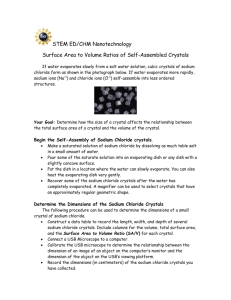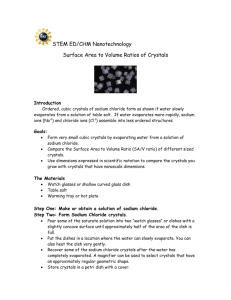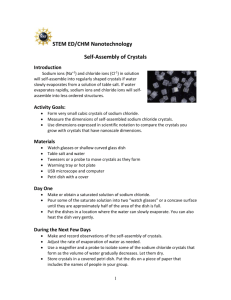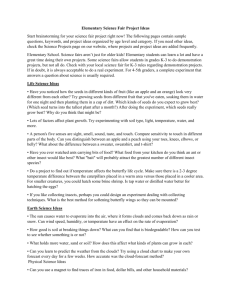STEM ED/CHM Nanotechnology at UMass Amherst
advertisement
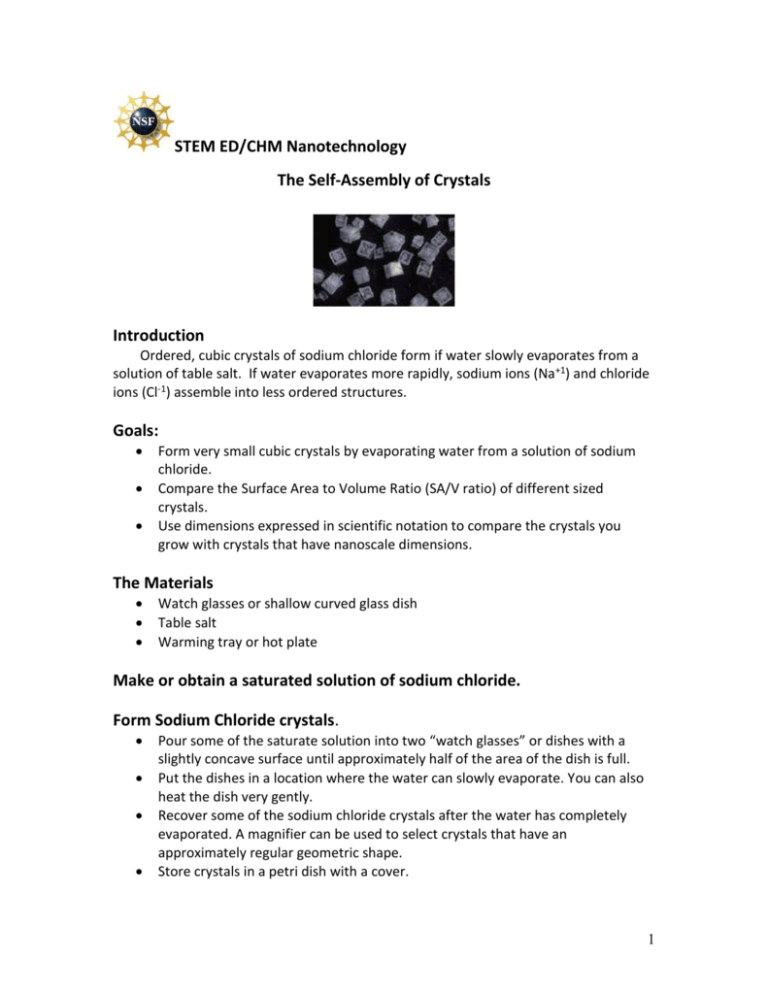
STEM ED/CHM Nanotechnology The Self-Assembly of Crystals Introduction Ordered, cubic crystals of sodium chloride form if water slowly evaporates from a solution of table salt. If water evaporates more rapidly, sodium ions (Na+1) and chloride ions (Cl-1) assemble into less ordered structures. Goals: Form very small cubic crystals by evaporating water from a solution of sodium chloride. Compare the Surface Area to Volume Ratio (SA/V ratio) of different sized crystals. Use dimensions expressed in scientific notation to compare the crystals you grow with crystals that have nanoscale dimensions. The Materials Watch glasses or shallow curved glass dish Table salt Warming tray or hot plate Make or obtain a saturated solution of sodium chloride. Form Sodium Chloride crystals. Pour some of the saturate solution into two “watch glasses” or dishes with a slightly concave surface until approximately half of the area of the dish is full. Put the dishes in a location where the water can slowly evaporate. You can also heat the dish very gently. Recover some of the sodium chloride crystals after the water has completely evaporated. A magnifier can be used to select crystals that have an approximately regular geometric shape. Store crystals in a petri dish with a cover. 1 Determine the Dimensions of Sodium Chloride Crystals The following procedure can be used to determine the dimensions of a small crystal of sodium chloride. Construct (or be given) a data table to record the length, width, and depth of several sodium chloride crystals. Include columns for the volume, total surface area, and a Surface Area to Volume Ratio (SA/V) calculation for each crystal. Connect a USB Microscope to a computer. Calibrate the USB microscope to determine the relationship between the dimension of an image of an object on the computer’s monitor and the dimension of the object on the USB’s viewing platform. Record the dimensions (in centimeters) of the sodium chloride crystals you have collected. Calculate the Total Surface Area and Volume of Each Crystal Calculate and record the total surface area of each crustal (in cm2) Calculate and record the volume of each crystal (in cm3) Calculate the Surface Area to Volume Ratio (SA/V). Show an example of a step by step calculation in an area below your data table. Note: the ratio is a raw numerical ratio and, thus, does not have a unit. An On-Line SA/V Calculator: You can use an on-line Surface Area to Volume Ratio calculator at: http://www.cod.edu/people/faculty/chenpe/sa-ratio.html Question 1: What happens to the value for the Surface Area to Volume Ratio as the size of the crystals decrease? Question 2: How might an increase in the value for the Surface Area to Volume Ratio for salt crystals affect the rate at which salt would dissolve in water? Question 3: Why would an increase in the value for the Surface Area to Volume Ratio for salt crystals affect the rate at which salt would dissolve in water? Question 4: What would be the challenges in designing an experiment to determine how the value for the Surface Area to Volume Ratio for salt crystals affects the rate at which salt would dissolve in water? 2 Surface Area to Volume Ratios at the Nanometer Scale: You have been using a centimeter ruler to analyze the Surface Area to Volume Ratio of salt crystals. A Surface Area to Volume Ratio can also be determined for a nanoscale structure. As an example, a nanoscale cubic crystal has a width of 4.5 nanometers. 4.5 nanometers is equal to 4.5 x 10-9 meters. You need to convert nanometers to centimeters so that you can compare a nanoscale crystal with a salt crystal that you analyzed. Question 5: How can 4.5 nanometers equal be expressed in centimeters? Question 6: What would be the Surface Area to Volume Ratio for a structure that is 16.5 nanometers wide, 120.0 nanometers long and 4.5 nanometers thick? Enter data as centimeters for that nanoscale structure on the data table. If you use the on-line calculator, you need to enter values as centimeters in decimal form. Questions 7: What can you conclude about the Surface Area to Volume Ratios for nanoscale structures? Question 8: What is the surface to volume ratio of a classroom or gymnasium? Question 9: How would you design an experiment to determine how a surface area to volume ratios affects the rate of a chemical reaction? Question 10: What are some examples of animals that have very high values and very low values for their surface area to volume ratios? 3
